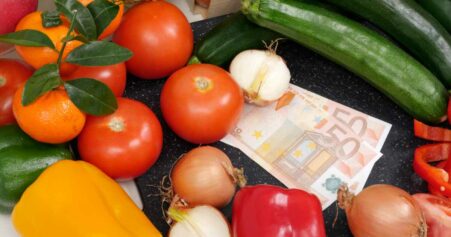Table of Contents
Tempeh = eating mold! We know that this probably does not sound appealing to you. But have you tried tempeh? How the mold develops, and why it can do more than just add flavor is explained in this article.
Did you know …
… that tempeh cannot only be made from soybeans?
Tempeh Production
Industrial Production
Tempeh is a traditional Indonesian food. It is usually made from soybeans, which must have a moisture content of about 14 %. After being cooked for five to ten minutes, they are soaked in cold water for 15 to 17 hours. They are then dried and hulled. Next is the characteristic production step: inoculation with the starter culture. This is a mold, such as Rhizopus oligosporus. Under a plastic cover, it allows the beans to ferment at room temperature. It takes about 35 to 37 hours for a coherent mass of beans to form, covered and penetrated by the fungus. This can be seen by the white mold coating (Coo et al., 2019).
The tempeh is then further processed as needed; it is sold in its natural form as well as marinated and seasoned. You can find it either freshly refrigerated or vacuumed and pasteurized in health food stores, online, Asian stores, or in some (organic) supermarkets.
Making Tempeh Yourself
It’s not that hard to make your own tempeh, but it does take some time and a warm place. Here’s how to do it:
- Boil and drain 600 grams of shelled soybeans.
- Put them back in the same pot on the hot, turned off stove. This will allow the beans to dry.
- Mix the beans with 6 tablespoons of vinegar and let them cool to about 32°C.
- Stir 1 teaspoon of tempeh starter culture (get it from a health food store or the Internet) evenly into the beans.
- Place the beans in a container, such as an open glass jar, in a plastic box. Alternatively, you can use a freezer bag with air holes 1 to 2 cm apart.
- Place the beans in a warm place (about 30 °C/86 °F) for 24 to 48 hours. You can use the oven (with the light on for extra heat) and a hot-water bottle, changing it about twice a day. Leave the oven door ajar so that air can get to the beans. This will allow the fermentation process to take place.
The amounts given are for about 1 kg of tempeh, but you can make more or less by adjusting the ingredients (according to WikiHow). By the way, you can also freeze tempeh, because unlike tofu, its texture does not change.
Taste and Nutrition Facts
Nutrient values vary, depending on the variety, producer, starter culture, and fermentation conditions (Coo et al., 2019). You can see the average nutrient values of tempeh in Table 1.
Table 1: Average Nutrient Values of Tempeh per 100 g (MRI, 2017)
| Energy | 165 kcal |
| Protein | 19.0 g |
| Carbohydrates | 1.8 g |
| Fiber | 6.5 g |
| Fat
from that saturated fatty acids |
7.6 g
1.1 g |
| Biotin | 53 µg |
| Folic Acid | 156 µg |
| Vitamin B12 | 0.8 µg |
| Potassium | 250 mg |
| Calcium | 142 mg |
| Magnesium | 230 mg |
| Iron | 5 mg |
| Zinc | 3.8 mg |
In general, tempeh is rich in B vitamins, calcium, iron, zinc, and isoflavones. Of particular interest for a vegan diet is the vitamin B12 and the provitamin D2 content. Additionally, tempeh provides a lot of protein, which is of high quality due to the soy it consists of.
Tempeh has a mild-nutty taste which reminds of cheese, its texture is quite firm.
Benefits of Fermentation
In the production of tempeh, fermentation is initiated by the added starter cultures. Other fungi, yeasts and bacteria present in the tempeh itself are also involved. This process gives tempeh its characteristic flavor and texture. But your health may also benefit from regular consumption of fermented foods.
Effects on the gut
Those who have trouble digesting soy – or legumes in general – may benefit from the improved digestibility of tempeh: This is because bacteria break down the hard-to-digest oligosaccharides.
In addition, animal studies and human gastrointestinal models have shown that tempeh alters the composition of the gut microbiota: The number of Bacteroidetes, Firmicutes, Bifidobacteria, and Lactobacillus increased. However, more studies are needed to prove the effects in the human body and to describe and evaluate possible effects (Cao et al., 2019).
Effects on Nutrient Bioavailability
There is also evidence that the bioavailability of vitamins, minerals, and isoflavones is higher in the fermented product. For example, bacteria (K. pneumoniae, C. freundii) in soybeans contribute to vitamin B12 production during fermentation (Cao et al., 2019). By combining different bacterial cultures, vitamin B12 production was further increased in lupine tempeh (Signorini et al., 2018).
The fermentation process also leads to the degradation of, for example, protease inhibitors, phytic acid and phenols, which can reduce the bioavailability of some nutrients. In addition, the water-soluble nitrogen content can be increased by proteolytic enzymes produced by the fungus. As a result, protein absorption is improved (Cao et al., 2019).

Other Potential Health Benefits
Depending on the type of fermentation process (for example depending on duration, whether incubation is aerobic or anaerobic or a combination, temperature, and type of cultures), antioxidant properties are increased (Tonolo et al., 2019; Chang et al., 2009; Cao et al., 2019). According to studies, this can be explained by the higher polyphenol content in the fermented product. In one study, the levels of the isoflavonoid aglycones genistein and daidzein doubled as a result of fermentation. They have higher antioxidant properties than the corresponding glycosides present without fermentation. Also of interest is the possible antimicrobial activity shown in vitro (cell experiments) against various microorganisms (for example Staphylococcus aureus) (Cao et al., 2019). In addition, there is evidence that tempeh consumption may have a beneficial effect on elevated serum cholesterol and blood pressure levels and may prevent tumor growth (Chang et al., 2009).
How to Use Tempeh
In addition to the “classic” tempeh made from soybeans, there is lupine tempeh, which is made from cooked lupine seeds incubated with the bacterium. Chickpeas or other beans can also be fermented in this way, and a combination with rice or other grains is also possible. In addition, manufacturers marinate or smoke tempeh after fermentation to add flavor.
It is best to boil, simmer, or steam tempeh for about 8 to 10 minutes first. This is not absolutely necessary, but it will soften its consistency. Then you can process the tempeh. Here are some ideas:
- marinate (e.g. in oil-spice mixture, soy sauce)
- frying (e.g. with coconut oil), possibly soaking in a salt solution beforehand
- deep-fry
- bread in breadcrumbs with soy flour and water (as egg substitute)
- slice and bake in the oven
- slice, crumble or chop as desired
- puree (e.g. with vegetables or legumes).
The prepared tempeh goes well with:
- wok dishes with fresh vegetables and rice
- salads
- soups
- appetizers, served with toppings of your choice (beet or nut puree goes well with it)
- bread, e.g. on a sandwich with avocado and salad.
Conclusion
While the idea of eating mold and bacteria may seem strange at first, there are many benefits to eating tempeh: nutty flavor, high protein and nutrient availability, and likely other health benefits. Once you know what it is good for and how versatile tempeh is, it’s actually pretty tempting to give the bacteria a chance.









Leave a Reply